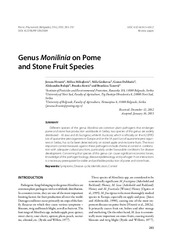Приказ основних података о документу
Genus Monilinia on pome and stone fruit species
Vrste roda Monilinia na jabučastim i koštičavim vrstama voćaka
| dc.creator | Hrustić, Jovana | |
| dc.creator | Mihajlović, Milica | |
| dc.creator | Grahovac, Mila | |
| dc.creator | Delibašić, Goran | |
| dc.creator | Bulajić, Aleksandra | |
| dc.creator | Krstić, Branka | |
| dc.creator | Tanović, Brankica | |
| dc.date.accessioned | 2020-12-17T20:25:42Z | |
| dc.date.available | 2020-12-17T20:25:42Z | |
| dc.date.issued | 2012 | |
| dc.identifier.issn | 1820-3949 | |
| dc.identifier.uri | http://aspace.agrif.bg.ac.rs/handle/123456789/2889 | |
| dc.description.abstract | Different species of the genus Monilinia are common plant pathogens that endanger pome and stone fruit production worldwide. In Serbia, two species of this genus are widely distributed - M. laxa and M. fructigena, while M. fructicola, which is officially on the A2 EPPO List of quarantine pest organisms in Europe and on the 1A part I List of quarantine pest organisms in Serbia, has so far been detected only on stored apple and nectarine fruits. The most important control measures against these pathogens include chemical control in combination with adequate cultural practices, particularly under favourable conditions for disease development. Concerning that species of this genus can cause significant economic losses, knowledge of the pathogen biology, disease epidemiology and pathogen-host interactions is a necessary prerequisite for stable and profitable production of pome and stone fruits. | en |
| dc.description.abstract | Različite vrste roda Monilinia dobro su poznati biljni patogeni koji ugrožavaju proizvodnju jabučastog i koštičavog voća širom sveta. U našoj zemlji široko su rasprostranjene dve vrste ovog roda - M. laxa i M. fructigena, dok je M. fructicola koja se zvanično nalazi na A2 EPPO listi karantinskih štetnih organizama u Evropi i na A1 listi karantinskih štetnih organizama u našoj zemlji, do sada detektovana samo na uskladištenim plodovima jabuke i plodovima nektarine. Najznačajnija mera borbe protiv ovih patogena je hemijsko suzbijanje uz primenu adekvatnih agrotehničkih mera, naročito u godinama povoljnim za razvoj oboljenja. S obzirom da vrste ovog roda mogu prouzrokovati velike ekonomske gubitke, stepen poznavanja biologije patogena, epidemiologije bolesti i odnosa parazit-domaćin predstavljaju neophodan preduslov stabilne i profitabilne proizvodnje jabučastog i koštičavog voća. | sr |
| dc.publisher | Institut za pesticide i zaštitu životne sredine, Beograd i Društvo za zaštitu bilja Srbije, Beograd | |
| dc.relation | info:eu-repo/grantAgreement/MESTD/Integrated and Interdisciplinary Research (IIR or III)/46008/RS// | |
| dc.relation | info:eu-repo/grantAgreement/MESTD/Integrated and Interdisciplinary Research (IIR or III)/43001/RS// | |
| dc.rights | openAccess | |
| dc.rights.uri | https://creativecommons.org/licenses/by-sa/4.0/ | |
| dc.source | Pesticidi i fitomedicina | |
| dc.subject | symptoms | en |
| dc.subject | disease cycle | en |
| dc.subject | identification | en |
| dc.subject | control | en |
| dc.subject | simptomi | sr |
| dc.subject | ciklus razvoja | sr |
| dc.subject | identifikacija | sr |
| dc.subject | suzbijanje | sr |
| dc.title | Genus Monilinia on pome and stone fruit species | en |
| dc.title | Vrste roda Monilinia na jabučastim i koštičavim vrstama voćaka | sr |
| dc.type | article | |
| dc.rights.license | BY-SA | |
| dc.citation.epage | 297 | |
| dc.citation.issue | 4 | |
| dc.citation.other | 27(4): 283-297 | |
| dc.citation.rank | M51 | |
| dc.citation.spage | 283 | |
| dc.citation.volume | 27 | |
| dc.identifier.doi | 10.2298/PIF1204283H | |
| dc.identifier.fulltext | http://aspace.agrif.bg.ac.rs/bitstream/id/1563/2886.pdf | |
| dc.type.version | publishedVersion |


